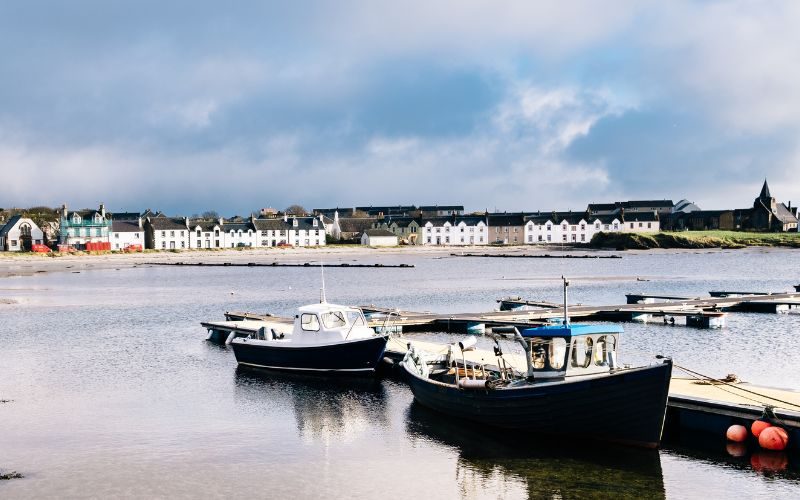Islay is the southernmost island in the Inner Hebrides. Inhabited since the Middle Ages by Gaels, Picts, and Norsemen. The geographical position implies a long distilling history due to its proximity to Ireland. Islay is also known as the “Queen of Hebrides”.
In the 1400s the island was the seat of one of the most powerful clans in Scotland. The MacDonalds, led by The Lord of Isles, Alexander MacDonald. Today the island calls Bowmore its capital.
Of the five whisky regions in Scotland, Islay is the indisputable ruler of a typically smoky and peaty style of single malts. The island has eight established distilleries (plus two new ones), and their whiskies have a complex character thanks to peat and marine influence. The water for whisky making flows in streams across the peat, picking up some of the earthy aromas and flavors that the distillery amplifies through the malting process.
Peat is a blackish or dark brown material formed by the partial decomposition of vegetable matter in the wet and acidic conditions of bogs, from which pieces are cut and dried for use as fuel.
To produce whisky with peat flavor and aroma, the distillery places the peat on top of the fire inside the kiln. The peated smoke generated by the kiln reaches the malting floor in the upper room and permeates the barley for hours until it’s complete dried. The level of peat is usually measured in terms of parts per million (PPM).
Here is a quick guideline for peat levels:
- Lightly peated – below 15 PPM
- Moderately peated – around 20 PPM
- Heavily peated – above 30 PPM
Single malts from Islay have distinctive seaweed, medicinal, and iodine flavors. Although peaty and smoky flavors are not exclusive to this region, Islay takes these characteristics to a different level. The flavors of Islay single malts provide a big and bold character to the Scotch blends because of their intensity. These flavors make Scotch Whisky famous and revered across the world.
Although Islay is a small island of only 239 sq miles, there are regional differences in distillery styles. The south part of the island is known for its sea salt flavors with iconic names like Ardbeg, Laphroaig, and Lagavulin. Following the coastal line on the way north, you will arrive at Bowmore, known for its “medium-dry” style. Keep driving north and arrive at the Bruichladdich with light to medium mouthfeel, now famous for its peaty Frankenstein single malts series known as Octomore.
Drive to the north part of the island and arrive at Kilchoman, characterized for its fruity yet peated style, a relatively new distillery that opened its doors in 2005. At the most northern part of the island is Bunnahabhain, perhaps the lightest peated style of the island with an oily, flowery, and delicious delicate character. Driving down the island facing the neighboring island Jura is Caol Ila, known for its smoke and dry style with a smooth finish.
For those new to the Islay single malts, here is a list of must-try expressions from each distillery that capture their core style:
Ardbeg Distillery
House Style: Rich and intense, earthy, smoky. A big and bold cult-like malt.
Must try: Ardbeg 10, Ardbeg Uigeadail.
Laphroaig Distillery
House Style: Seaweed, highly medicinal and oily.
Must try: Laphroaig 10, Laphroaig 10 Cask Strength. Laphroaig Lore, and Laphroaig Quarter Cask.
Lagavulin Distillery
House Style: Intense, dry, smoky, and robust body that shines as a sherry-matured peated malt.
Must try: Lagavulin 8, Lagavulin 16, Lagavulin Distiller’s Edition.
Bowmore Distillery
House Style: Medium peat. Warm and rounded. A malt that shines when matured in sherry casks at an older age.
Must try: Bowmore 15, Bowmore 18.
Bruichladdich Distillery
House Style: Fruity and light-bodied with peat and smoke. The Octomore series contains some of the most highly peated single malts ever.
Must try: The Classic Laddie-Scottish Barley, Port Charlotte 10 (40ppm).
Check my review on The Classic Laddie-Scottish Barley here.
Kilchoman Distillery
House Style: Rich with sweet notes and peat.
Must-try: Kilchoman Machir Bay, Kilchoman Sanaig.
Bunnahabhain Distillery
House Style: Oily and flowery, gentle peat. A delicate malt.
Must-try: Bunnahabhain 12, Bunnahabhain 18, and Bunnahabhain 11 Year Old Limited Release French Brandy Cask Finish.
Caol Ila Distillery
House Style: Fruity, peaty and dry. Smoke flavors and aromas shine in Coal Ila.
Must Try: Caol Ila 12, Caol Ila 18 (UK), and Caol Ila Cask Strength.
Other Islay Distilleries
The following distilleries I have yet to try:
Port Ellen Distillery: The defunct southern distillery closed its doors in 1983 and has become a cult-like malt adored by whisky collectors and anoraks. Port Ellen malts command a significant price in auction houses around the world.
Ardnahoe Distillery. Opened in 2018. Location: Port Askaig.
Farkin Distillery. Opened in 2021. Its location is outside of Port Ellen in the southern part of the island.
You can visit the Scotland official website for all whisky regions here. I would love to know know which is your favorite Islay Single Malt: Scotland official website for whisky areas, like Islay here.
Slainte!





